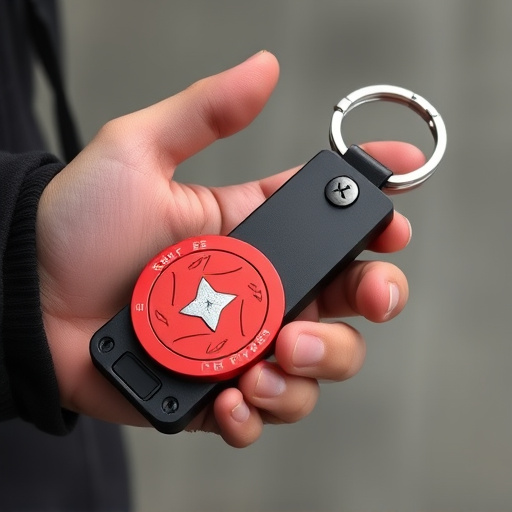Understanding the legal classification of pocket-sized keychain defense weapons (PSKDW) is crucial for global self-protection. With varying regulations in the EU and US, knowledge of local laws ensures compliance and safe possession. PSKDW users must follow specific rules for public carry, licensing, registration, and training to avoid legal repercussions while employing these tools as a last resort.
“As the popularity of pocket-sized keychain defense weapons surges, understanding their legal requirements is crucial. This comprehensive guide navigates the intricate world of keychain safety devices, offering a global perspective on their classification, usage, and ownership. From regional regulations to safety measures, we explore what it takes to legally carry these compact self-defense tools. Whether you’re armed with knowledge or just curious, this article provides insights into ensuring responsible use and avoiding legal pitfalls.”
- Understanding Legal Definitions: Keychain Defense Weapons and Their Classification
- Regional Regulations: A Global Perspective on Pocket-Sized Self-Defense Tools
- Permitted Usage: When and Where Can You Legally Carry a Keychain Defense Device?
- Licensing and Registration: Uncovering Requirements for Ownership and Carrying
- Safety Measures: Ensuring Responsible Use and Avoiding Legal Pitfalls
Understanding Legal Definitions: Keychain Defense Weapons and Their Classification
When navigating the legal landscape surrounding keychain safety devices, understanding the precise definitions and classifications is paramount. The term ‘keychain defense weapons’ typically refers to compact, pocket-sized tools designed for personal protection. These devices often take various forms, including knifes, pepper spray, or stun guns, each classified differently under the law.
Legal frameworks differentiate these weapons based on factors like blade length (for knives), active ingredients and dosage (for pepper spray), and voltage or current output (for stun guns). Regulatory bodies may also consider aspects such as capacity, range, and power source. Being aware of these classifications is crucial for ensuring compliance with local laws and avoiding any potential legal repercussions when carrying a keychain defense weapon.
Regional Regulations: A Global Perspective on Pocket-Sized Self-Defense Tools
In today’s globalized world, regional regulations play a pivotal role in shaping the legality of pocket-sized keychain defense weapons. What may be permitted in one country could face stringent restrictions or even be banned in another. For instance, many European Union countries have stricter controls on personal defense tools due to concerns over misuse and public safety, while the United States generally allows for more lenient regulations, with some states recognizing the right to carry pocket-sized self-defense devices for personal protection.
Understanding these regional disparities is crucial for individuals considering the purchase or possession of keychain defense weapons abroad. Travelers and expatriates should familiarize themselves with the local laws before introducing such items into their new environment. Additionally, manufacturers and distributors must adhere to international standards and regulations to ensure their products can be legally marketed and sold worldwide, avoiding potential legal complications and ensuring consumer safety.
Permitted Usage: When and Where Can You Legally Carry a Keychain Defense Device?
In many jurisdictions, pocket-sized keychain defense weapons are legal if used for personal protection within specific parameters. These devices can be carried in public spaces as long as they comply with local self-defense laws and regulations. Typically, this means you cannot brandish or use them aggressively, but rather have them readily accessible to deter or escape a potential threat. Public places like shopping malls, parks, and walking trails are generally acceptable areas for legal carriage.
It’s crucial to understand the permitted usage varies across regions, so checking local laws is essential before carrying any keychain defense device externally. Some areas may restrict their use to self-defense within one’s residence or vehicle, while others might allow open carry in public with certain restrictions. Staying informed about these regulations ensures you remain on the right side of the law and can effectively protect yourself if needed.
Licensing and Registration: Uncovering Requirements for Ownership and Carrying
In many jurisdictions, pocket-sized keychain defense weapons, often designed for personal safety, are subject to strict licensing and registration processes. Before owning or carrying such a device, individuals must navigate these requirements, which vary significantly from region to region. Licensing typically involves applying for a permit through designated government agencies, providing proof of identity, and possibly undergoing background checks to ensure the user’s suitability.
Registration is another crucial step, where details about the specific type of keychain defense weapon, its purchase, and the owner are documented. This process aims to track these devices and their users, fostering accountability and ensuring compliance with local laws. Understanding and adhering to these legal mandates are essential for anyone considering carrying a pocket-sized keychain defense weapon to protect themselves in unexpected situations.
Safety Measures: Ensuring Responsible Use and Avoiding Legal Pitfalls
When it comes to pocket-sized keychain defense weapons, safety measures are paramount. These small devices can be powerful tools for personal protection, but their use must adhere to strict legal requirements and responsible practices. Users should receive adequate training on proper handling and deployment techniques, ensuring they understand the potential consequences of misuse. Many jurisdictions have specific regulations regarding self-defense weapons, including keychain defense devices, so it’s crucial to research and comply with local laws to avoid legal pitfalls.
Manufacturers and retailers play a vital role in promoting safe use by providing clear instructions, warnings, and responsible ownership information. This includes detailing appropriate scenarios for using such devices, emphasizing their limited application as a last resort for self-defense. By combining responsible user practices, transparent manufacturer guidelines, and adherence to legal frameworks, individuals can leverage these compact defense tools while mitigating potential risks and ensuring compliance.
When it comes to carrying a keychain safety device, understanding the legal landscape is paramount. With varying regional regulations and specific requirements for ownership and use, ensuring compliance is crucial. Pocket-sized keychain defense weapons, while offering convenient self-defense options, must be employed responsibly and within legal boundaries. By familiarizing yourself with local laws, obtaining necessary licenses, and adhering to safety guidelines, you can effectively navigate the legal aspects of carrying a keychain defense device, ultimately fostering personal security without compromising the law.
